ASUS F1A75-I Deluxe Review – Llano and Mini-ITX
by Ian Cutress on October 1, 2011 5:30 PM EST- Posted in
- Motherboards
- Asus
- A75
BIOS
The ASUS UEFI is becoming pretty entrenched in our reviews of ASUS boards now as one of the better UEFI implementations currently available. As I write, ASUS are still on the release BIOS for the F1A75-I Deluxe, which is what I have here, and it works as it should with no issues.
I should point out that as this board has not been released, the BIOS is technically still not an official release. This will most likely change in the near future.
The front page represents the easy mode of BIOS tuning, detailing all the important information every manufacturer should give on the front page – the board name, the BIOS version, the CPU and CPU frequency, total memory and speed, temperatures, voltages and fan speeds. The system performance option allows users to apply preset ASUS settings for low power, standard, or enhanced performance. Also, users can adjust the boot priority using the drag and drop icons at the bottom, or boot from a selected device with a double click. One thing I did notice is that my USB device that was selectable later on in the BIOS was not present in this boot priority menu.
For more detailed options, users must navigate to the advanced mode, which gives a more standard BIOS feel to it.
The AI Tweaker menus give the overclock options. Left on automatic (in normal power mode on the easy BIOS screen), these will default to stock settings – including my memory at DDR3-1333 and CL9, despite it being rated much faster. With memory being an important factor in Llano graphics, and the A75 platform, currently released processors will support DDR3-1600 or DDR3-1866 - there is rather an elaborate way of implementing XMP on this board, by selecting the DOCP profile and navigating through a submenu.
Along with the overclock and memory options, all of which are fully featured, the voltage section allows either an offset to be applied, or a selectable value. There are no options to change any of the integrated graphics clock settings, however. This has to be done in the operating system using Catalyst software.
The fan settings for the two onboard headers are adjustable through the UEFI or in the operating system – any setting made in the UEFI will make its way into the OS software for manual graphic manipulation.
On default settings, the SATA configuration will revert to IDE mode. I can see that there are various reasons for being in IDE mode automatically for compatibility, though I would hazard a guess and say the users of this board will most likely be using relatively newer SATA drives and an AHCI compatible operating system, meaning I would prefer AHCI by default and the extra performance it gives.
The integrated graphics part of the BIOS can force the on chip graphics, even when a discrete GPU is present (presumably for GPU simulation/OpenCL), or when the discrete GPU can be put into CrossFireX with the integrated graphics for improved performance. Here we can also set the memory reserved for the integrated GPU, in predefined levels up to 2 GB.
Overclocking
If this board were to have a serious issue, from the perspective of functionality beyond specifications, it would be the overclocking.
In terms of automatic overclocking features, the BIOS has the OC Tuner option, and the OS has software which enables a ‘Fast’ OC and an ‘Extreme’ OC. In my experience, the OC Tuner and ‘Fast’ options performed similarly, giving a 3% overclock in the base clock from 100 MHz to 103 MHz. Memory frequency similarly received a 3% bump, rather than applying the inbuilt XMP profiles which I would have expected.
The ‘extreme’ preset is a more aggressive form of overclock, configuring and testing the system until a suitable maximum is reached. When this button is clicked (for a non-black edition Llano CPU), the base clock is adjusted up 1 MHz at a time, stress tested for a short time, and at every multiple of 10 MHz the system restarts. On previous platforms, I have had no issue with this preset – usually it has applied more voltage than ideal, but it works well in the majority of situations. Here however, there is a slight problem. After going up to 110 MHz, the system rebooted, and failed to recover. Upon loading Windows, it would blue screen (with the characteristic of a failed overclock), and end up in restart loop. In the end, I manually had to reduce the BIOS speed to 107 MHz to get a successful OS start up.
In terms of manual overclocking, this is fairly straight forward. I manually increased the CPU voltage to 1.5 V, the memory voltage to 1.65 V, and adjusted the base clock. However, I could not get the machine to boot above 107 MHz. No matter what settings I used (included a set which ASUS gave me involving adjusting the CPU current limits), the 107 MHz barrier would not be breached.
Overclocking in the operating system was a different matter altogether. Using the ASUS Suite II software, when using a discrete GPU, I could happily adjust the base clock to 120 MHz under stock voltage and it was stable through 2D and 3D tests. Unfortunately this setting is not kept between boots, and requires manual application every time. While using the integrated graphics, using this method, I could not go beyond 110 MHz.
As a result of this situation it is almost impossible to recommend this board as an overclocking board. Due to the design and low profile nature, I would be happier running this board at stock, but users will have to manually adjust the memory speed to something more useful for the Llano processor.
Update:
I approached ASUS with this issue regarding the overclocking. They suggested that I may get a better overclock when using IDE mode for my SATA ports rather than my default of using AHCI to keep the SATA port testing equivalent.
In IDE mode, overclocking is a different story. While on the discrete GPU, I was able to boot at 140 MHz no trouble, effectively moving from 2600 MHz to 3640 MHz, with all settings in the BIOS on auto. 145 MHz caused similar OS booting issues to AHCI mode beyond 105 MHz, but a 40% overclock is a brilliant result to get.
Using DDR3-2133 MHz memory (9-11-9), at 140 MHz, the BIOS settings gave me a choice of DDR3-1866 and DDR3-2240 speeds on their respective dividers. With the memory subtimings set at auto, only DDR3-1866 worked, with 9-9-9 subtimings being applied automatically. I was able to boot at DDR3-2240 if I loosened the subtimings, but DDR3-1866 CL9 represents a standard Llano kit that people would buy and it managed this easily.
By using ASUS’ recommended settings, and bumping up the CPU voltage beyond that given at 140 MHz by the Auto setting, I was unable to improve on 140 MHz as an overclock, which leaves 140 MHz a good benchmark for this processor.
In terms of pure throughput, this 3640 MHz setting gave a boost in 3DPM from 66.27 to 93.42 in single threaded mode, and from 224.68 to 315.21 in multithreaded mode.
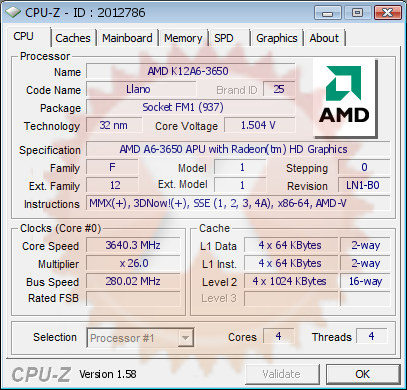
(CPU-Z does not correctly record the Bus Speed yet,
however the overall Core Speed is correct.)


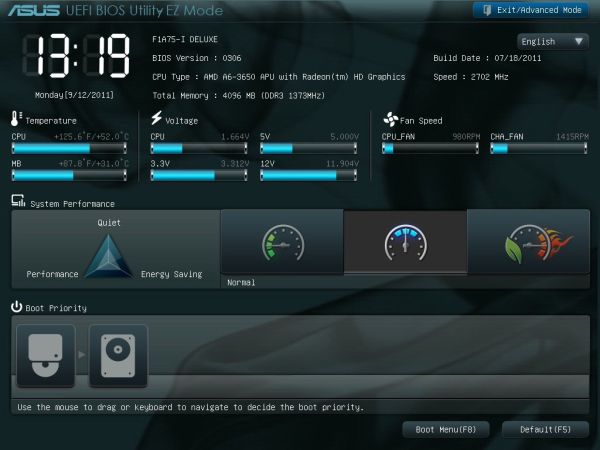
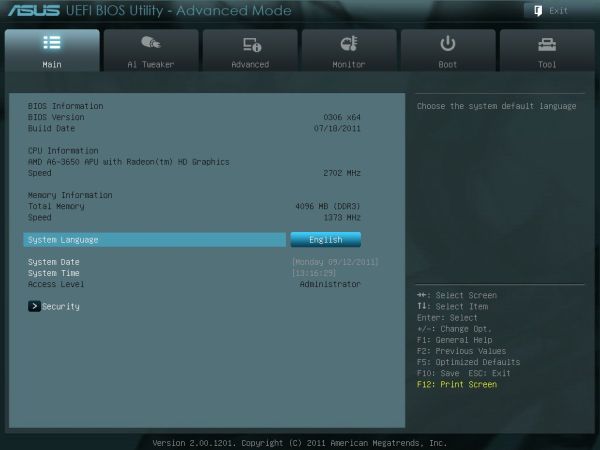
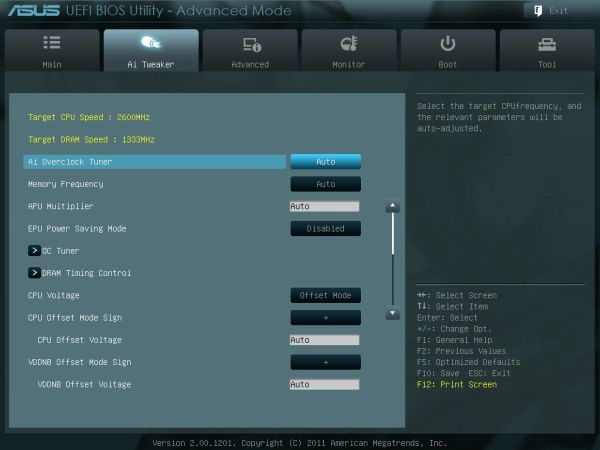

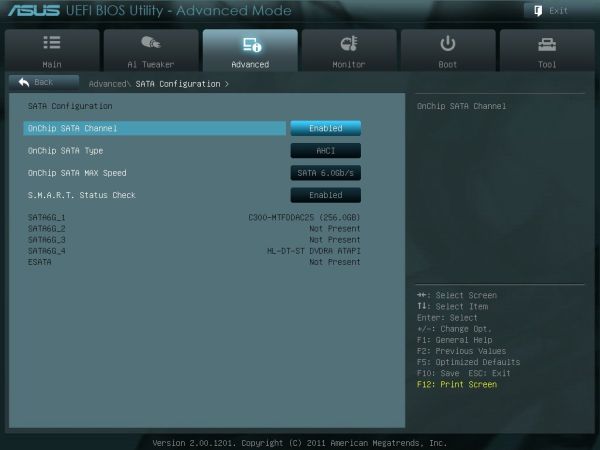
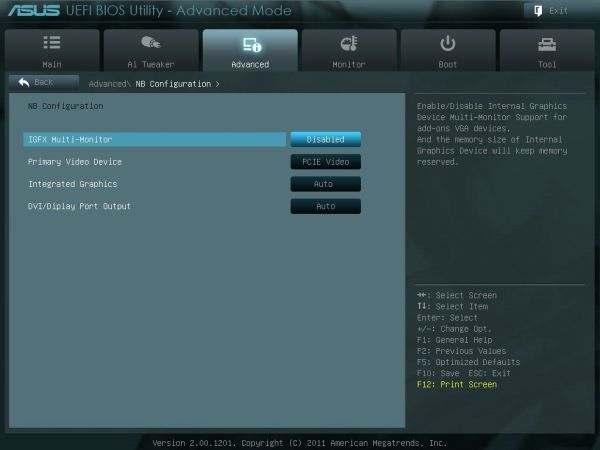














51 Comments
View All Comments
jensend - Saturday, October 1, 2011 - link
Glad to see at least one manufacturer put two usb3 ports on the back and included a header for the A75's other ports. ASRock's board wouldn't allow for any front usb3 ports or any internal usb3 devices (usu. card readers).But $145 is a bit steep for my taste. Hopefully they'll come out with a cheaper version sans remote.
Death666Angel - Saturday, October 1, 2011 - link
"this board has not been released"I can buy this board at 14 different online stores and they have it in store. Unless Europe/Germany has a different ASUS F1A75-I Deluxe, this thing is released as can be. :-)
Also, it costs 45€ more than the AsRock I got and the only difference I see is the AsRock has no WLAN, no remote and no DP. For me, I made the right choice. :D
Iketh - Saturday, October 1, 2011 - link
Why in the world is a 1000W PS being used for this system???? Use a 350w silver or even less.... I stopped reading when I saw thatAnandThenMan - Sunday, October 2, 2011 - link
The make Llano look bad, there is no other logical explanation. Well except gross incompetence to use such a PS for this platform.Death666Angel - Sunday, October 2, 2011 - link
It's the curse of a standardized test system:you save quite a bit of time and have overall the better comparison between tests, but you do end up making some things look worse than they are, since one size doesn't fit all.
I think you are reading too much into this. If you want to see how this (obvious HTPC board) fares with a HTPC setup, go look for another site that specializes in it. :-)
Intel Motherboards are tested with the same setup btw and they are looking about as good as Llano here, I think. And when you look at the initial SNB review, you have idle numbers for the i3 3100 of 73W (they don't list the used PSU in those reviews), which is quite a lot worse than Llano and some Athlons in that test.
http://www.anandtech.com/show/4083/the-sandy-bridg...
:D
Soulkeeper - Saturday, October 1, 2011 - link
1.35 V is the lowest dram voltage it will let you select ?Any idea if future bios can/will allow lower ?
Soulkeeper - Saturday, October 1, 2011 - link
Does this keyboard function like a standard wireless usb keyboard ?IE: it doesn't need special drivers and will work in linux ?
hp79 - Saturday, October 1, 2011 - link
AMD really sucks. 50 Watt of power in idle with integrated GPU is really terrible.I have a intel i3-2120 with 8GB ram, 1 SSD, 1 HDD, GTX 460 1GB on a intel mini-itx board, which is housed in Lian Li PC-Q11 and that uses only 45W power on idle. When playing games, the case stays really quiet and takes around 100W to 140W. By the way, I have a Antec 380W 80 plus power supply.
Imagine what it'll look like if I take off that power hungry graphics card since intel HD2000 has no problem handling multimedia stuff.
50W idle for AMD Llano is really a shame. Especially since energy usage is directly related to heat, and space is a premium for HTPCs or mini-itx cases, 50W idle is really not a good choice.
One thing I have to thank AMD is for it wasn't for them, intel would have been less innovative, and who knows we might have been stuck with Pentium D's today. I don't expect much from AMD's but I hope they can continue to offer some mid-end, low-end competition so we can buy intel's good stuff for cheap. i3-2120 plus H61 motherboard for $110 is an amazing price.
nubie - Sunday, October 2, 2011 - link
Um, did you see the guy above you complaining about the 1000watt power supply?Maybe that is the cause of the power draw being so high.
These results only are comparable with a computer using the 1000watt power supply.
I would love to see a PC using the Xbox360 power brick for example, 203Watt was the highest spec they came in, newer ones are close to 100watt.
hp79 - Sunday, October 2, 2011 - link
Yes, I read his comment after reading the whole article. I also thought the 1000W power supply was awkward, but still shouldn't be the reason using that much power. It's a 80 Plus PSU, and an expensive one.I also have a AMD Athlon X3 435 which uses 55W on idle with nforece integrated graphics. Another reason I don't like AMD is that the performance was lower than a cheap ass $30 Celeron E3300 when I tested playing games with a GT240 graphics card on both of them. No more AMDs in my house.